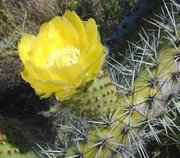Opuntia
From Wikipedia, the free encyclopedia.
| Prickly Pears & Chollas | ||||||||||||
|---|---|---|---|---|---|---|---|---|---|---|---|---|
 Teddy-bear Cholla & Prickly Pear |
||||||||||||
| Scientific classification | ||||||||||||
|
||||||||||||
| Species | ||||||||||||
| Many, see text |
Opuntia is a genus in the cactus family Cactaceae. Both prickly pears and chollas are included in this genus of about 250 species distributed throughout most of the New World. The type species of the genus is the Indian Fig Opuntia Opuntia ficus-indica.

Prickly pears, classified in the subgenus Opuntia, typically grow with flat, rounded segments that are armed with two kinds of spines; large, smooth, fixed spines and small, almost hairlike spines that easily penetrate skin and detach from the plant. Many types of prickly pear can grow into dense, tangled structures. Prickly pears are the only types of cacti normally found in the eastern United States, and are the most cold-tolerant of the cacti, extending north into southern Canada.
Chollas, classified in the subgenus Cylindropuntia, are distinguished by having cylindrical, not flattened, stem segments, and with the large spines barbed. Some botanists treat Cylindropuntia as a distinct genus. The stem joints of several species, notably the Jumping Cholla (Opuntia fulgida), are very brittle on young stems, readily breaking off when the barbed spines stick into clothing or animal skin; this helps distribute the cholla as when the stem falls off the person or animal, it is able to take root and grow where it falls. The barbed spines often remain embedded in the skin, causing significant discomfort and sometimes injury.
The fruit of opuntias, called tuna, is edible, although it has to be peeled carefully to remove the small spines on the outer skin before consumption. It is often used to make candies and jelly. The young stem segments, called nopales, are also edible.
Prickly pears in Australia
Prickly pears (mostly O. stricta) were imported into Australia in the 1920s for use as a natural agricultural fence, but quickly became a widespread weed, rendering 40,000 km² of farming land unproductive. The Cactoblastis moth, a South American moth whose larvae eat prickly pear, was introduced in 1925 and almost wiped out the infestation. This case is often cited as a "textbook" example of successful biological pest control. The same moth, introduced accidentally further north of its native range into southern North America, is causing serious damage to some native species in that area.
Example species
- Subgenus Opuntia True prickly pears. Often difficult to identify, due to hybridization.
- Opuntia basilaris - Beavertail Cactus; found in southwest U.S. and northwest Mexico.
- Opuntia chlorotica - Pancake Prickly Pear; native to southwest U.S. and the Sonoran an Mojave deserts.
- Opuntia engelmannii - Engelmann's Pear (also called Calico Cactus, Engelmann Prickly Pear). The tunas, their fruit, are a major food in Mexico.
- Opuntia erinacea - Grizzly Bear Opuntia.
- Opuntia ficus-indica - Indian Fig Opuntia; native range is unknown, probably Mexico; cultivated in warm parts of the world for its edible fruit.
- Opuntia fragilis - Little Prickly Pear, Brittle Cactus; found in the northern Great Plains and as far west as British Columbia, also found in the southern Great Plains
- Opuntia humifusa (syn. Opuntia compressa var. humifusa) - Eastern Prickly Pear; found throughout the U.S. east of the Great Plains and into southern Ontario
- Opuntia leucotricha - Arborescent Prickly Pear (other common names: Aaron´s Beard Cactus, Semaphore Cactus, Duraznillo Blanco, Nopal Blanco); a tree-like cactus, growing up to 5 m tall, occurring in the mountains of Central Mexico.
- Opuntia lindheimeri - Texas Prickly Pear).
- Opuntia littoralis - Sprawling Prickly Pear.
- Opuntia macrocentra - Black Spine Prickly Pear or Purple Prickly Pear; found in southwest U.S. and northern Mexico.
- Opuntia macrorhiza - Plains Prickly Pear; found throughout the Great Plains except for the northernmost areas (not found in North Dakota), and extending sporadically eastward as far as Kentucky.
- Opuntia microdasys - Bunny Ears; found in Mexico (Hidalgo).
- Opuntia phaeacantha - New Mexico Prickly Pear.
- Opuntia polyacantha - Plains Prickly Pear.
- Opuntia pusilla - Creeping Cactus.
- Opuntia santa-rita - Santa Rita Prickly Pear; found in Texas, Arizona and northern Mexico.
- Opuntia stricta - Spineless Prickly Pear, Coastal Prickly Pear.
- Subgenus Cylindropuntia. Chollas.
- Opuntia acanthocarpa - Buckhorn Cholla
- Opuntia arbuscula - Pencil cholla
- Opuntia bigelovii - Teddy-bear Cholla
- Opuntia echinocarpa - Silver Cholla
- Opuntia fulgida - Jumping Cholla
- Opuntia imbricata - Cane Cholla, Tree Cholla
- Opuntia leptocaulis - Desert Christmas Cactus
- Opuntia ramosissima - Diamond Cholla
- Opuntia spinosior - Tasajo Cholla
- Opuntia stanlyi - Devil Cholla
- Opuntia versicolor - Staghorn Cholla
- Opuntia whipplei - Rat-tail Cholla
External link
- Prickly Pear Cactus (http://www.desertusa.com/magoct97/oct_pa/du_prkpear.html) in the North American desert.

Categories: Cacti | Fruit








